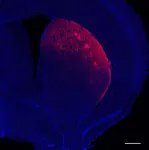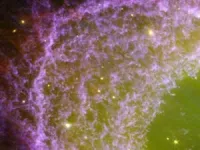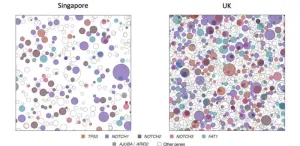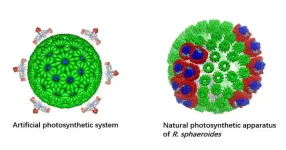(Press-News.org)
Dopamine: It’s not just for rewards anymore.
In a new Northwestern University-led study, researchers identified and recorded from three genetic subtypes of dopamine neurons in the midbrain region of a mouse model.
Although there is a long-standing, common assumption that most — if not all — dopamine neurons solely respond to rewards or reward-predicting cues, the researchers instead discovered that one genetic subtype fires when the body moves. And, even more surprisingly, these neurons curiously do not respond to rewards at all.
Not only does this finding shed new light on the mysterious nature of the brain, it also opens new research directions for further understanding and potentially even treating Parkinson’s disease, which is characterized by the loss of dopamine neurons yet affects the motor system.
The study will be published on Thursday (Aug. 3) in the journal Nature Neuroscience.
“When people think about dopamine, they likely think about reward signals,” said Northwestern’s Daniel Dombeck, who co-led the study. “But when the dopamine neurons die, people have trouble with movement. That’s what happens with Parkinson’s disease, and it’s been a confusing problem for the field. We found a subtype that are motor signaling without any reward response, and they sit right where dopamine neurons first die in Parkinson’s disease. That’s just another hint and clue that seems to suggest that there’s some genetic subtype that’s more susceptible to degradation over time as people age.”
“This genetic subtype is correlated with acceleration,” added Northwestern’s Rajeshwar Awatramani, who co-led the study with Dombeck. “Whenever the mouse accelerated, we saw activity, but in contrast we did not see activity in response to a rewarding stimulus. This goes against the dogma of what most people think these neurons should be doing. Not all dopamine neurons respond to rewards. That’s a big change for the field. And now we found a signature for that dopamine neuron that does not show reward response.”
Dombeck is a professor of neurobiology at Northwestern’s Weinberg College of Arts and Sciences. Awatramani is the John Eccles Professor of Neurology at Northwestern University Feinberg School of Medicine. The paper’s first authors are Maite Azcorra and Zachary Gaertner, both graduate students in Dombeck’s and Awatramani’s laboratories.
Motor-driving signals
This new discovery builds on a previous study from Dombeck’s lab, which found a population of dopamine neurons associated with movement in mice.
“At the time, we thought it was just a tiny fraction of neurons,” Dombeck said. “And others continued to assume that all dopamine neurons were still reward neurons. Maybe some of them just had motor signals too.”
To probe this question further, Dombeck teamed with Awatramani, who used genetic tools to isolate and label populations of neurons based on their gene expression. Using this information, Dombeck’s team then tagged neurons in the brains of a genetically modified mouse model, which was generated at the Northwestern Transgenic and Targeted Mutagenesis Lab, with fluorescent sensors. This enabled the researchers to see which neurons glowed during behavior — ultimately revealing which neurons control different specific functions.
In the experiments, about 30% of dopamine neurons only glowed when the mice moved. These neurons were one of the genetic subtypes that Awatramani’s team identified. The other populations of dopamine neurons responded to aversive stimuli (causing an avoidance response) or to rewards.
The Parkinson’s connection
For decades, researchers have been confounded by why patients with Parkinson’s disease lose dopamine neurons yet have difficulties moving.
“It’s not like people with Parkinson’s disease only lose their drive to be happy because their dopamine response is damaged,” Dombeck said. “Something else is going on that affects motor skills.”
Dombeck and Awatramani’s new study might provide the missing piece to the puzzle.
In their work, the researchers noted that dopamine neurons correlated with acceleration in mice appear to be in the same location of the midbrain as those that tend to die in patients with Parkinson’s disease. But the dopamine neurons that survive are correlated with deceleration. The discovery leads to a new hypothesis that Dombeck and Awatramani plan to explore in the future.
“We’re wondering if it’s not just the loss of the motor-driving signal that’s leading to the disease — but the preservation of the anti-movement signal that’s active when animals decelerate,” Dombeck said. “It could be this signal imbalance that strengthens the signal to stop moving. That might explain some of the symptoms. It’s not just that patients with Parkinson’s can’t move. It could also be that they are being driven to stop moving.”
“We’re still trying to figure out what this all means,” Awatramani said. “I would say this is a starting point. It’s a new way of thinking about the brain in Parkinson’s.”
The study, “Unique functional responses differentially map onto genetic subtypes of dopamine neurons,” was supported by Aligning Science Across Parkinson’s (ASAP-020600) through the Michael J. Fox Foundation for Parkinson’s Research, the National Institutes of Health (award numbers R01MH110556, 1R01NS119690-01, P50 DA044121-01A1, 1S10OD025120, 1S10OD011996-01 and 1S10OD026814-01), La Caixa Fellowship of Postgraduate Studies in North America and Asia, National Institute of Neurological Disorders and Stroke (award number 1F31NS115524-01A1) and the National Institute of General Medical Sciences.
END
RESEARCH SUMMARY
Study Title: Mammalian SWI/SNF chromatin remodeling complexes promote tyrosine kinase inhibitor resistance in EGFR-mutant lung cancer
Publication: Cancer Cell
Dana-Farber Cancer Institute Senior and Lead Authors: Cigall Kadoch, PhD; Claudia Gentile, PhD; Akshay Sankar
Study Summary:
When lung cancers driven by mutations in the EGFR gene become resistant to osimertinib or other targeted therapies, epigenetic changes, rather than genetic changes, are often to blame. In a new study in Cancer Cell, researchers at the Dana-Farber Cancer Institute and Yale Cancer Center show that the main source of these changes are ...
About 55 million years ago, the Atlantic Ocean was born. Until then, Europe and America were connected. As the continents began to move apart, the Earth’s crust between them ruptured, releasing large volumes of magma. This rift volcanism has led to the formation of large igneous provinces (LIPs) in several places around the world. One such LIP was formed between Greenland and Europe and now lies several kilometres below the ocean surface. An international drilling campaign led by Christian Berndt from the GEOMAR ...
NASA's James Webb Space Telescope (JWST) has recorded breath-taking new images of the iconic Ring Nebula, also known as Messier 57.
The images, released today by an international team of astronomers led by Professor Mike Barlow (UCL, UK) and Dr Nick Cox (ACRI-ST, France), with Professor Albert Zijlstra of The University of Manchester, showcase the nebula's intricate and ethereal beauty in unprecedented detail, providing scientists and the public with a mesmerizing view of this celestial wonder.
For many sky enthusiasts, the Ring Nebula is a well-known object that is visible all summer long and is located in the constellation ...
SKIN CANCER-RELATED MUTATIONS HIGHER IN THE UK THAN SINGAPORE
A new study has shown how, on average, people in the UK have facial skin that is far more DNA damaged from the sun than people in Singapore, explaining the far higher risk of developing the most common skin cancers in the UK.
This study looked at keratinocyte cancers - basal and squamous cell carcinomas - rather than melanoma, a rarer and sometimes fatal form of skin cancer, finding Northern European skin types in the UK were less able to protect themselves from UV damage.
Researchers from the Wellcome Sanger Institute and their collaborators at ...
UK researchers are calling on higher education institutes and research funders to adopt a new set of recommended actions to address the substantial under-representation of PhD students from ethnic minority backgrounds.
Black, Asian and minority ethnic students have a markedly lower representation in postgraduate research compared with undergraduate or taught postgraduate study in the UK. For instance, in 2020/21, around 26.5% of UK undergraduates were from ethnic minority backgrounds, compared with around 19% for postgraduate students.
The ...
A joint research team from City University of Hong Kong (CityU) and collaborators recently developed a stable artificial photocatalytic system that is more efficient than natural photosynthesis. The new system mimics a natural chloroplast to convert carbon dioxide in water into methane, a valuable fuel, very efficiently using light. This is a promising discovery, which could contribute to the goal of carbon neutrality.
Photosynthesis is the process by which chloroplasts in plants and some organisms use sunlight, water and carbon dioxide to create food or energy. In past decades, many scientists have tried to develop artificial photosynthesis processes to turn ...
About The Study: In this study of 1.4 million birthing person–infant pairs in the U.S., most pregnancy-specific alcohol policies were not associated with decreased odds of infant injuries or morbidities. Policy makers should not assume that pregnancy-specific alcohol policies improve infant health.
Authors: Sarah C. M. Roberts, Dr.P.H., of the University of California, San Francisco, is the corresponding author.
To access the embargoed study: Visit our For The Media website at this link https://media.jamanetwork.com/
(doi:10.1001/jamanetworkopen.2023.27138)
Editor’s ...
Digital Science, a technology company serving stakeholders across the research ecosystem, is pleased to announce that Nottingham Trent University has chosen Altmetric Explorer from Digital Science’s flagship products to improve the measurement and reporting of social media and alternative metrics.
Nottingham Trent University (NTU) has signed a deal to utilise Altmetric to report on societal impact and dissemination of research.
Using Digital Science’s products and tools, NTU will be able to support its research strategy, impact development, dissemination ...
Seven entrepreneurs will embark on a two-year fellowship as the seventh cohort of Innovation Crossroads kicks off this month at the Department of Energy’s Oak Ridge National Laboratory. Representing a range of transformative energy technologies, Cohort 7 is a diverse class of innovators with promising new companies.
New to Innovation Crossroads’ sponsorship this year are DOE’s Office of Electricity and Office of Science Advanced Scientific Computing Research program, which join DOE’s Advanced Materials and Manufacturing Technologies Office, DOE’s Building Technologies Office, and the Tennessee ...
Highlights:
Since its inception in 2014, Insilico Medicine has developed multiple AI models for predicting the probability of success of clinical trials focusing on Phase II to Phase III transition probabilities.
To validate the models, it pursued three strategies - retrospective, quasi-prospective, and prospective validation.
In 2016, it deposited on a preprint server the first date-stamped article with the predictions of clinical trials.
The publication titled “Prediction of clinical trials outcomes based on target choice and clinical trial design with multi‐modal artificial intelligence” ...








